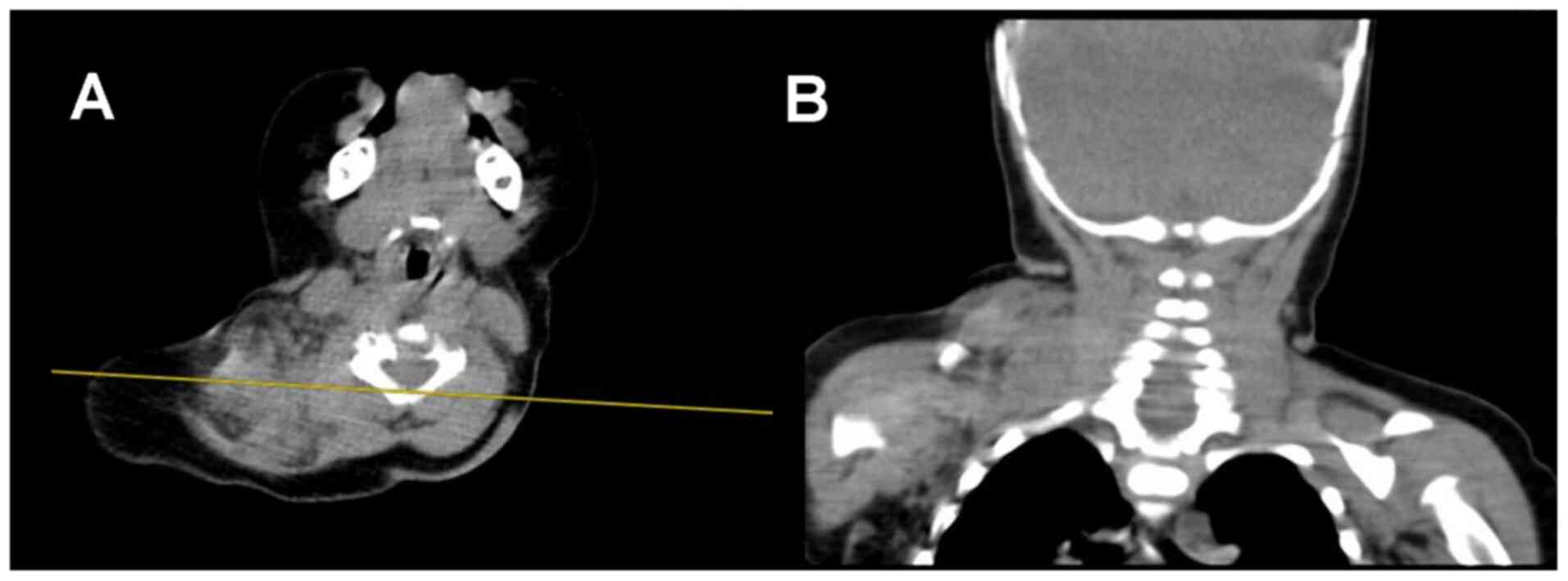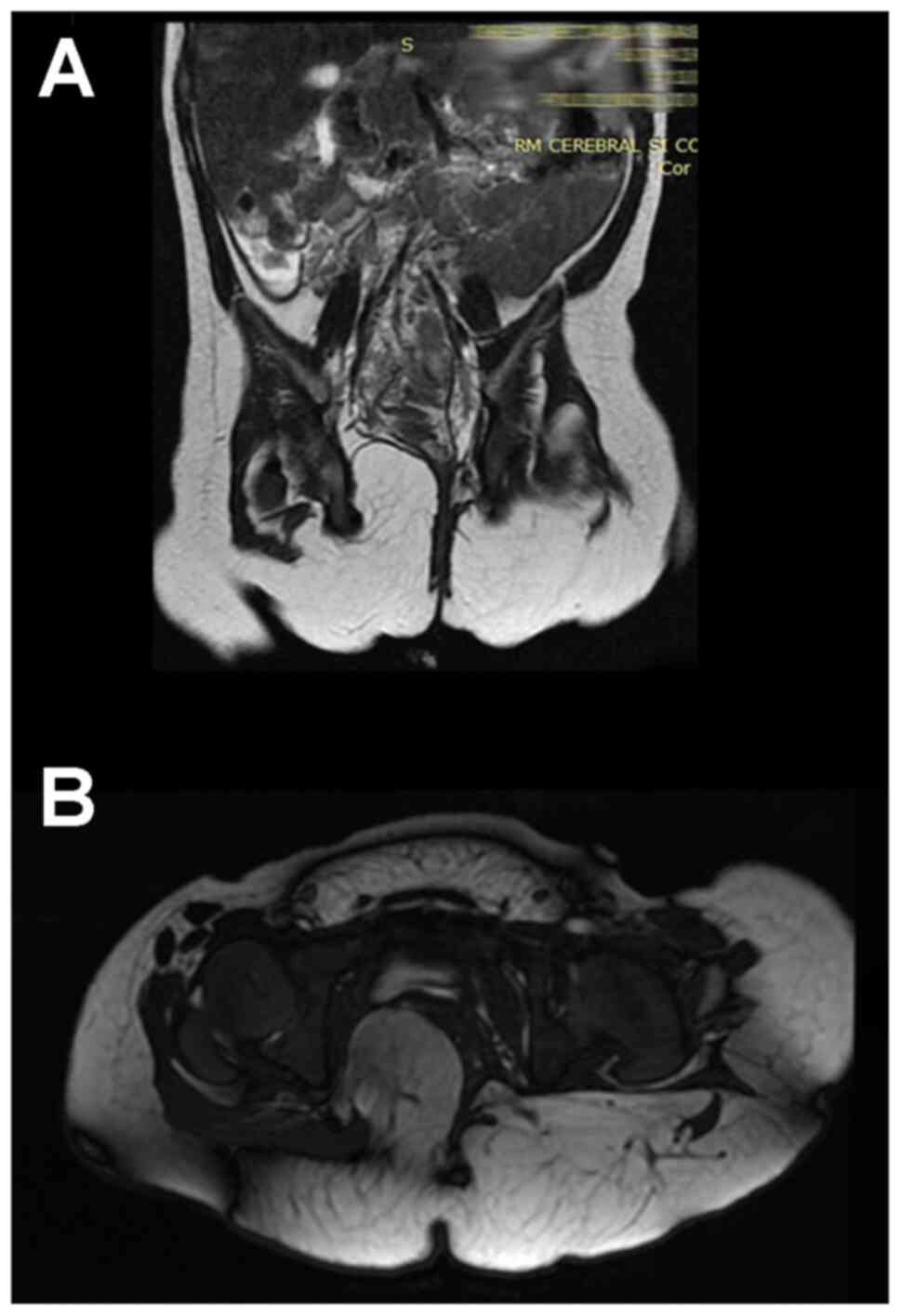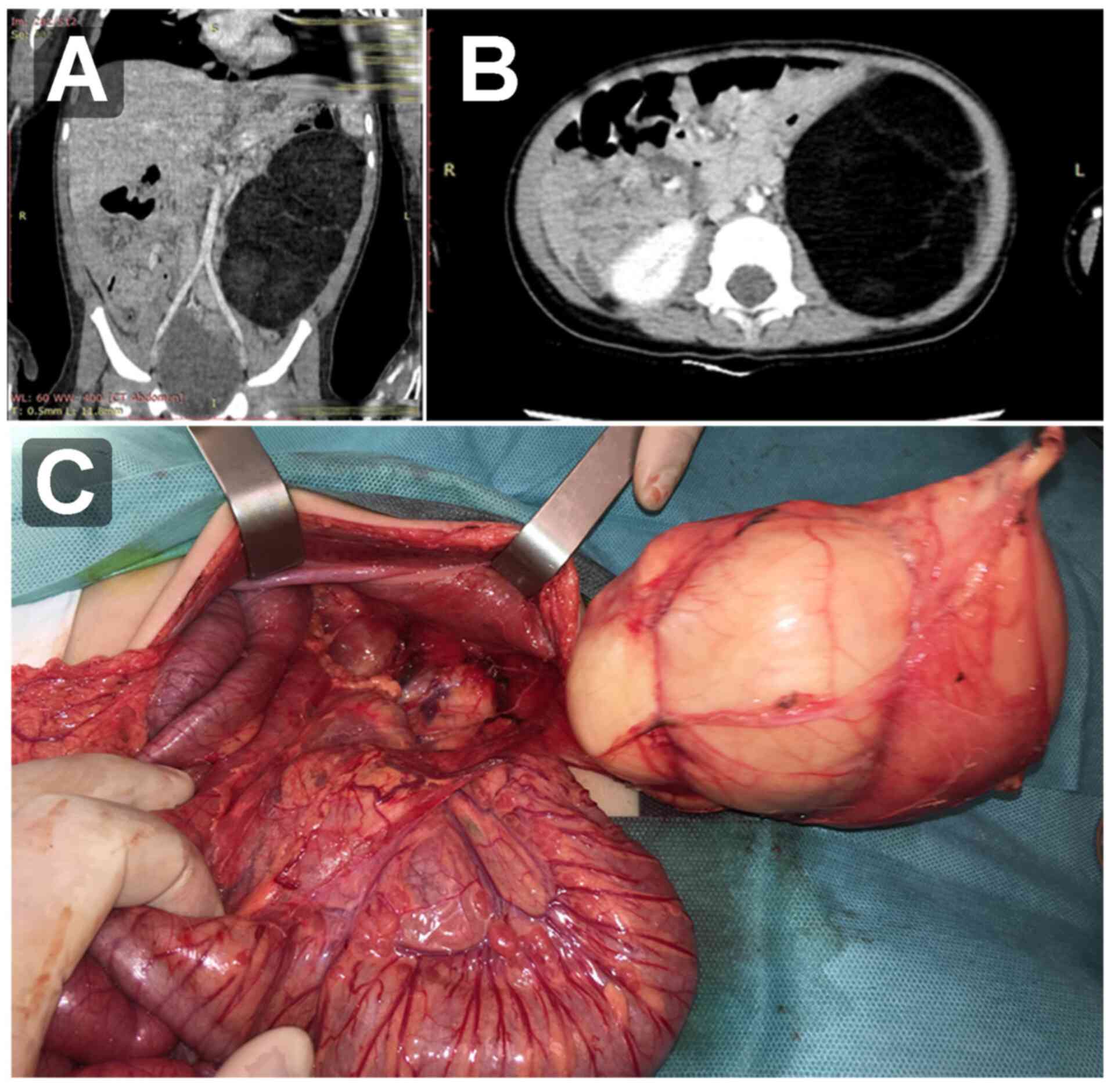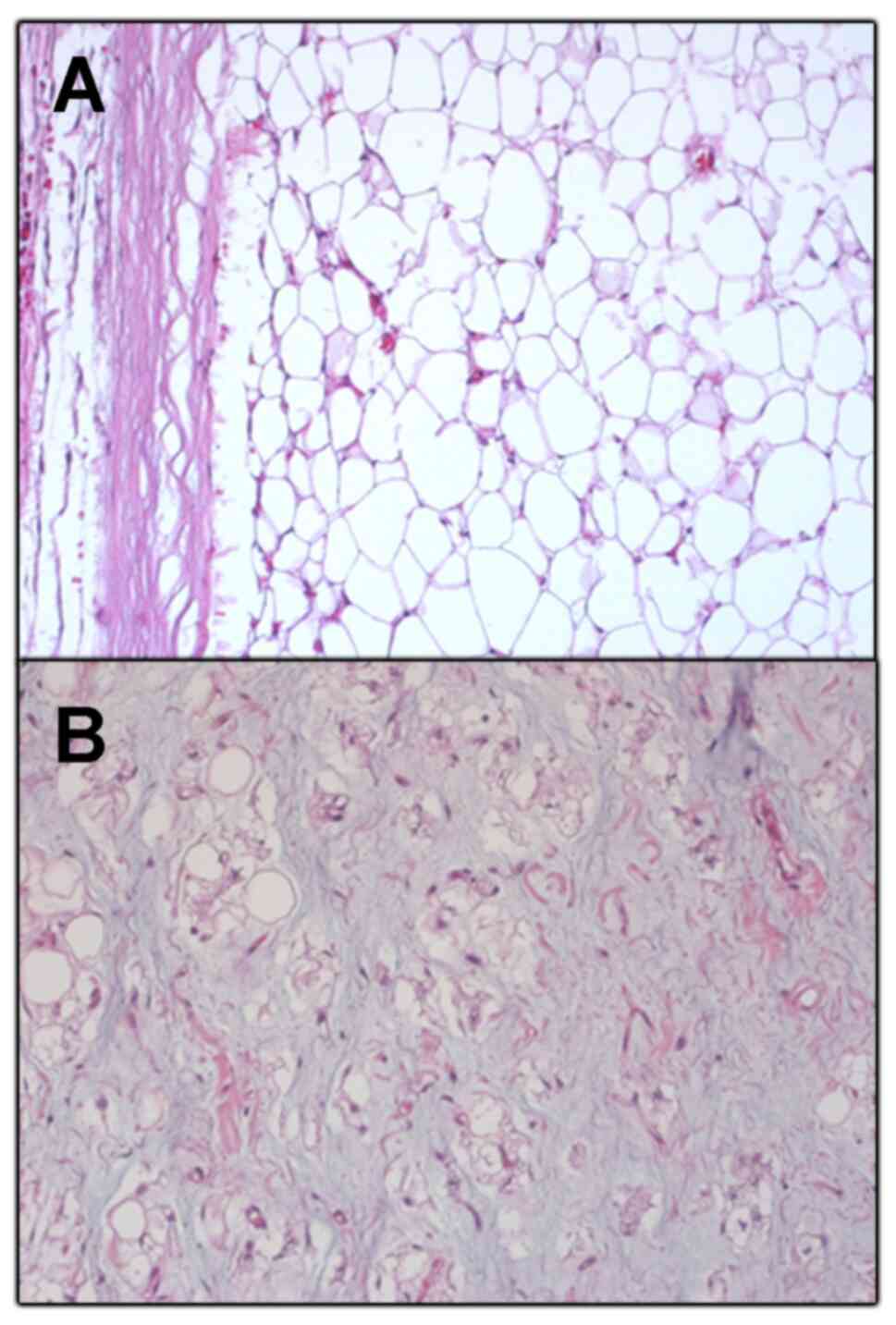Lipoblastoma: Diagnosis and surgical considerations
- Authors:
- Published online on: June 24, 2021 https://doi.org/10.3892/etm.2021.10335
- Article Number: 903
-
Copyright: © Spătaru et al. This is an open access article distributed under the terms of Creative Commons Attribution License.
Abstract
Introduction
Lipoblastomas (LB) are benign tumors rising from embryonic white fatty cells that continue to proliferate and develop during the postnatal period (1,2). They are diagnosed almost exclusively in pediatric population and most of the cases are encountered in infants and children under 3 years of age; more frequently in male patients with a male:female ratio ranging from 1.7 to 3:1 (3,4). Most lipoblastomas are well-encapsulated tumors and malignant degeneration changes have not been reported to date. However, local recurrence is noted in several reports. Lipoblastomatosis (LBS), an uncommon variant in LB presentation, is defined as a multicentric, infiltrative form of presentation of the tumor, where the tumor has a diffuse, unclear distinction from the nearby tissues (1-5). LB vary widely in anatomical location. The most affected regions reported are the subcutaneous tissue of the trunk and limbs (3), but intrathoracic, intraabdominal, head, neck, axillary, inguinal or genital localizations are occasionally described in the literature (1-11). They usually present as a solitary soft palpable mass, usually painless (3,5). On the other hand, radiological finding of an unharmful well-delimited mass responsible for its enlarging dysmorphic effect is rare, but well known (3). The size and the relatively growing pattern of the LB guide its surgical indication. The cosmetic aspects, the mass effect or the broad spectrum of the localization of the LB (some of them requiring a cautious attitude) can influence the surgeon's decision. Histopathologic examination along with immunohistochemistry is the standard of definitive diagnosis, while complete surgical excision is the current mainstay treatment (2,9,11,12).
Patients and methods
We reviewed 8 LB cases, managed by a single team from Emergency Clinical Hospital for Children ‘Marie S. Curie’, Bucharest, between 2016 and 2019. Informed consent was obtained from the patient's parents. All of the cases were diagnosed by immunohistochemistry. We reviewed the patient age at surgery, the site of the tumor, follow-up time and recurrence. However, our main aim was to emphasize our results and the perioperative clinical observations in the management of these rare tumors; diagnostic pitfalls, considerations or surgical challenges that we met are reviewed here.
Results
The age at surgery of the patients ranged from 7 to 36 months (mean age, 8 months; median age, 22 months). The male/female ratio was 1.6 (5:3). The mean period of follow-up was 32 months (median, 29 months); the most recent patient being operated 6 months prior to the study. We considered three cases having the traits of LBS. No recurrence was noted to date. None of the patients were referred for pain.
All the LB originating in the subcutaneous fat layer (cases no. 1-4) were noted by parents 2 months to 2 years prior to surgery (mean, 7 months; median, 13 months) and, after an initial ultrasound evaluation, indication for surgery was realized by the growing pattern of the tumor to subsequent clinical and ultrasonographic evaluations. In all cases of this subgroup, except for case no. 3, computed tomography (CT) or magnetic resonance imaging (MRI) scanning was indicated for a more detailed preoperative planning for vessel and nerve dissection and none considered LB as a preoperative diagnosis. Langer's line incisions in all case were conducted for cosmetic reasons. In all cases, follow-up was conducted by clinical examination and ultrasound. Further on, perioperative observations are emphasized.
A subcutaneous palpable mass in the right axillary region was diagnosed at 19 months of age in a female patient (case no. 1). Surgery was performed shortly after the identified extension of the tumor to the ipsilateral pectoral area and supraclavicular fossa. CT scan prior to surgery was suggested for the localization of the mass (Fig. 1). Intraoperative examinations revealed a soft mass, organized in islands of adipose-like tissue, having a poor delineation by a very thin connective tissue membrane from the adjacent structures. No difficulties in the dissection were noted, except for the close well-delimited contact to the axillary vein. Due to its unsystematic growth, spread and poor delineation it was labeled as LBS. No recurrence was noted after 22 months of follow-up.
In case no. 2, a 36-month-old male underwent surgery for a very well-delimited LB developed in the subcutaneous fatty tissue adjacent to the lumbar spine. The CT scan showed that the tumor was not infiltrating the posterior thoraco-lumbar fascia (Fig. 2). Complete excision was performed, and no recurrence was noted 2 years after surgery.
Case no. 3 was a 17-month old male, admitted for a growing difference between the circumferences of the thighs, in which the CT scan revealed a mass located in the anterolateral aspect of the right thigh (Fig. 3A-C). Intraoperative exploration showed a solitary round mass, that had developed between the muscles of the anterior compartment (Fig. 3D). Complete excision was performed and no recurrence was noted at the 8-month follow-up.
In regards to preoperative misleading diagnosis, we identified three situations (cases no. 4-6) in which LB was initially considered as lymphatic malformation, spermatic cord cyst, and sacrococcygeal teratoma, respectively.
In case no. 4 (a 9-month-old patient), the presumption of lymphatic malformation was made due to its similar imagistic and clinical characteristics. The subcutaneous palpable mass had developed in the left paragluteal region (Fig. 4A). An MRI was done demonstrating the tumoral extension only in the subcutaneous tissue (Fig. 4B). The tumor was composed of locally disseminated, relatively well-delimited cluster-like tumors, alternating with clear fluid small cysts having a poor blood supply (Fig. 4C). No recurrence was noted at the 50-month follow-up after excision.
Case no. 5 was a 27-month-old male patient, initially diagnosed as having a spermatic cord cyst. He was surgically operated on via a lower inguinal crease incision revealing a well-encapsulated lipomatous tumor adjacent to the spermatic cord, protruding through the superficial inguinal ring and bordering the epididymis. No recurrence was noted at the 43-month follow-up.
Parents of a 7-month-old female toddler noted a gluteal lump 1 month prior to surgery. The patient also had associated Dravet's syndrome (case no. 6). On digital rectal examination, we did not note any changes in tissue consistency in the presacral region. Following an MRI examination (Fig. 5) (presacral component identified) a diagnosis of type 2 sacrococcygeal teratoma was made (serum β-human chorionic gonadotropin and α-fetoprotein levels were within normal values). The tumor was poorly delineated, infiltrating the gluteal muscles and extending cranially in the presacral space. It was resected together with the coccyx, through a Chevron incision. The diagnosis of LBS was made considering its macroscopic traits, low delineation and infiltrative behavior and the pathological aspect. No local recurrence, fecal incontinence or soiling were noted at 51 months of follow-up.
In the following two cases (cases no. 7 and 8), the diagnosis was delayed considering the low sensitivity of the ultrasonography. Abdominal distension was the only clinical sign noted in both cases and repeated ultrasonographic evaluation performed prior to presentation in our clinic revealed only bowel distension by gas or fluid; both children being under differential diagnostic work-up for functional disorders.
A 19-month-old male patient (case no. 7) with symptoms of progressive abdominal distension was evaluated with CT scan in our clinic, after repeated false-negative ultrasonographic examinations in the prior months. A lipomatous, homogenous tumor was revealed in the retroperitoneal space in the left flank (Fig. 6A and B). Open approach via a midline incision was performed. The tumor was well-encapsulated and delineated in the left retroperitoneal fat adjacent to the kidney, sigmoid and transverse colon. Complete excision was able to be performed (Fig. 6C), and no recurrence was noted at 53 months of follow-up.
Moreover, in case no. 8 (a 14-month-old male patient), a CT scan of the abdomen was performed after six months of progressive abdominal distension in contrast with repeated false-negative ultrasound exams. The work-up was delayed because of poor family compliance. The CT scan revealed a poor delineated impressive abdominal mass (Fig. 7A and B). Excision via midline incision was performed. Dissection was challenging as the infiltrative, poor-delimitated, cluster-like tumors were spread between the superior mesenteric vessels from the mesentery root to marginal branches adjacent to the terminal ileum, cecum and ascending colon (Fig. 7C and D). No bowel ischemic complications or prolonged ileus were noted postoperatively. No recurrence was noted at 6-months of follow-up in this case of LBS.
Discussion
In our series there was a 5:3 (1.6) male:female ratio and a median age at surgery of 22 months, comparable to a large review of the literature of more than 263 case observations by Shen et al (3). Ninety percent of the lipoblastomas (LB) were identified in the first 3 years of life, while 10% were diagnosed in the first 12 months, similar to the present study in which all cases were diagnosed at an age younger than 36 months (13).
LB and LBS, along with angiolipoma, myolipoma, lipomatosis or hibernoma are benign fat tissue tumors, while liposarcomas are malignant, but exceptionally rare in children (3,14). Other soft tissue tumors which may be included in the differential diagnosis of LBs are embryonal rhabdomyosarcoma or myxoid malignant fibrous histiocytoma, or other rare tumors encountered in children (15,16). Although adipose tumors of childhood are only 6% soft tissue tumors, of which 95% are benign (17), other fat forming tumors such as solitary fibrous tumors have been reported in the literature (18). These predominantly develop in the deep soft tissues of the retroperitoneum and thigh, but also at the pleural level (19). LB is focal, well-circumscribed, has a more superficial presentation and a tendency to mimic lipoma, while LBS is diffuse, infiltrative of deeper tissue layers, with a higher recurrence rate (2), similar to 3 of our reviewed cases. In our series, two situations of preoperative misleading imaging and clinical characteristic of the tumor were noted. In case no. 4, multiple fluid cysts suggested a diagnosis of lymphangioma, while in case no. 6 the clinical aspects of the tumor misled to a postoperative presumption of sacrococcygeal teratoma.
Regarding the surgical decision, the well-documented benign characteristics gives LB the advantage that radical surgery may not be mandatory, considering its mutilating perspectives depending on its localization and the predominant children population in which the tumor is identified. Still, a recurrence rate between 14 and 25% is reported, highly influenced by the LBS subgroup. Moreover, a nonoperative attitude was proposed by Mognato et al in a report mentioning a newborn with spontaneous involution of the tumor within 8 months (13). Initially close dynamic observation of the tumor's expansion through proper imaging tools and, eventually, biological markers are mandatory. Subsequently, according to its rapid growth attribute (20), we believe surgical excision should be maintained as the standard treatment in order to relieve its symptoms, to avoid developmental issues or for cosmetic reasons in this order and keeping in mind that a disfiguring procedure should be avoided in presumed LB, until histopathological examination may backtrack this consideration. McVay et al suggest that special attention be given regarding the invasion of deeper structures of the neck, paraspinous region or abdomen by LB, recommending MRI evaluation of any possible central nervous system invasion (2). Neck LB were reviewed by Pham et al in a series of 48 cases, considering this localization as a clinical challenge as these tumors are often invasive and extend through critical structures in a ‘tentacle-like’ manner, making them prone to high morbidity; therefore, a careful follow-up is recommended in these cases (21). However, age is essential to differentiate LB from myxoid liposarcoma, the second one being found in older age patients, after 15 years of life (13).
Even if most of the cases in the literature report insidious mild symptoms, a relative mass effect or an aesthetic effect, mediastinal localization may be life-threatening, displaying acute respiratory distress, poor feeding or tachycardia, requiring urgent challenging surgery and anesthesia due to displacement of the trachea, heart, bronchi or close contact to the pericardium (22,23).
LB is scarcely reported with associated conditions in the current literature and these should not be ignored since, in recent years, several studies have detailed the oncogenic consequences of pleomorphic adenoma gene 1 (PLAG1) alterations. Malformations such as cleft lip, cleft palate, cephalic malformations and neurologic disorders have been reported together with LB cases (24-26). Therefore, a closer look at chromosome 8 (the PLAG1 location) is justified. In the presented case series, we encountered one case of LBS associated with Dravet's syndrome. This case strengthens Coffin et al observations of coexisting neurological disorders, including seizures (24). Regarding the surgical aspects in the case of presacral LB, some authors report sacral spinal canal invasion (2,27). There is a reported coexistence between lipoma and other tumors such as meningioma and also brain tumors with lipomatous features such as meningioma or cystic meningioma (28,29). Ahn et al mentioned coexisting anorectal malformation (perineal groove type) with perineal LB, but these were entirely intrapelvic tumors, either perineal presentations (30). In our situation, the aspect of the tumor was similar to an Altman II type sacrococcygeal teratoma.
Preoperative diagnosis is not accurate in the case of LB. Radiological diagnosis seems to be limited in LB, and CT and MRI can underestimate the size of the lesion (2). Ultrasound may show a homogenous hyperechoic mass or mixed echogenicity and fluid-filled spaces, this aspect being very delicate when the radiologist examines the abdomen whereas the tumor develops between the bowels. CT scan is highly suggestive for identification of the fatty component where small areas of contrast enhancement may be seen (8). In addition to the tumor extension, the goal of radiological evaluation is to evaluate the fat relative proportion to the associated myxoid tissue; these aspects being confirmed afterward in the pathological examination. Fat suppression technique in MRI helps confirm the fatty tissue component. In older children, fat tissue seem to be a dominant constituent, while in infants myxoid tissue with scarce adipose elements seem to be characteristic (21). All of this confusing preoperative imaging aspects should guide the surgeon to a deeper clinical analysis and should favor the operative approach in younger ages, contrary to the belief of a ‘wait and see’ attitude to avoid disfiguring procedures (2).
Pathologically (Figs. 8 and 9), LB is a benign tumor covering the whole spectrum of adipose tissue differentiation stages: From spindled and stellate cells in a myxoid background having a plexiform vascular pattern to multivacuolated cells with a central indented nucleus and monovacuolated cells with a marginal flattened nucleus (mature adipocytes) (31). Immunohistochemistry staining is recommended in all lipomatous tumors of children with ambiguous morphology (1).
In conclusion, LB are uncommon tumors encountered in childhood. They are benign, quick growing tumors which can have an insidious presentation when they develop in internal, less visible anatomical spaces. Radiological evaluation may be confusing, missing the diagnosis or misleading to more common similar imagistic aspects such as vascular tumors or lymphatic malformations. However, despite its rarity, we should keep in mind a diagnosis of LB in ambiguous imagistic cases and to point out possible pitfalls between fluid, gas or fat tissue description. Regarding the surgical aspects, LB is challenging based on two aspects. The tumor boundaries of LBS are not so well defined and the recurrence risk is high. Due to its ubiquity, originating from embryonal fat tissue, with a local invasive growing pattern, LBS can develop and be closely situated to essential anatomical structures and this can turn a non-cancerous tumor excision into an operative pitfall with potential unexpected unfavorable outcomes. Surgery should be the mainstay of treatment. LB is a fast-growing tumor with possible mass effect and its subsequent symptomatology, developmental problems or cosmetic effects. Yet, the moment of operation and its extent should be carefully evaluated according to patient age, localization and dimensions of the tumor.
Acknowledgements
Not applicable.
Funding
Funding: No funding was received.
Availability of data and materials
All data generated or analyzed during this study are available in this published article.
Authors' contributions
RIS and DAI contributed directly to the patient diagnoses and surgical management. RIS, DAI and CC designed, conceived and wrote the manuscript. DS, AE and LFT reviewed the information and edited the article. All authors approved the final manuscript for publication.
Ethics approval and consent to participate
The present study was approved by the Ethics Committee of ‘Maria S. Curie’ Emergency Clinic Hospital for Children. Informed consent was obtained from all of the parents of the patients.
Patient consent for publication
Not applicable.
Competing interests
The authors declare that they have no competing interests.
References
|
Abdul-Ghafar J, Ahmad Z, Tariq MU, Kayani N and Uddin N: Lipoblastoma: A clinicopathologic review of 23 cases from a major tertiary care center plus detailed review of literature. BMC Res Notes. 11(42)2018.PubMed/NCBI View Article : Google Scholar | |
|
McVay MR, Keller JE, Wagner CW, Jackson RJ and Smith SD: Surgical management of lipoblastoma. J Pediatr Surg. 41:1067–1071. 2006.PubMed/NCBI View Article : Google Scholar | |
|
Shen LY, Amin SM, Chamlin SL and Mancini AJ: Varied presentations of pediatric lipoblastoma: Case series and review of the literature. Pediatr Dermatol. 34:180–186. 2017.PubMed/NCBI View Article : Google Scholar | |
|
Armenise T, Gentile O, Orofino A, Leggio S, Lanzillotto MP, Zullino F and Paradies G: Lipoblastoma in infant: Our experience. J Pediatr Surg Case Rep. 3:63–64. 2015. | |
|
Chun YS, Kim WK, Park KW, Lee SC and Jung SE: Lipoblastoma. J Pediatr Surg. 36:905–907. 2001.PubMed/NCBI View Article : Google Scholar | |
|
Abel RM, Bryan RT, Rafaat F, Haigh F, Sethia B and Parikh D: Axillary lipoblastoma-tumor recurrence in the right atrium. J Pediatr Surg. 38:1246–1247. 2003.PubMed/NCBI View Article : Google Scholar | |
|
Eyssartier E, Villemagne T, Maurin L, Machet MC and Lardy H: Intrascrotal lipoblastoma: A report of two cases and a review of the literature. J Pediatr Urol. 9:E151–E154. 2013.PubMed/NCBI View Article : Google Scholar | |
|
Moholkar S, Sebire NJ and Roebuck DJ: Radiological-pathological correlation in lipoblastoma and lipoblastomatosis. Pediatr Radiol. 36:851–856. 2006.PubMed/NCBI View Article : Google Scholar | |
|
Mollaian M, Shahgholi E, Ghodsi M and Oskuoei AK: Intrathoracic lipoblastoma in a 8 month old infant. J Pediatr Surg Case Rep. 56(101429)2020. | |
|
Nagano Y, Uchida K, Inoue M, Ide S, Shimura T, Hashimoto K, Koike Y and Kusunoki M: Mesenteric lipoblastoma presenting as a small intestinal volvulus in an infant: A case report and literature review. Asian J Surg. 40:70–73. 2017.PubMed/NCBI View Article : Google Scholar | |
|
Mahmoud ME, Al-Onazi M, Al-Otaibi A and Asiri S: Huge retro-peritoneal lipoblastoma in 3 year old child. J Pediatr Surg Case Rep. 40:50–52. 2019. | |
|
Dilley AV, Patel DL, Hicks MJ and Brandt ML: Lipoblastoma: Pathophysiology and surgical management. J Pediatr Surg. 36:229–231. 2001.PubMed/NCBI View Article : Google Scholar | |
|
Mognato G, Cecchetto G, Carli M, Talenti E, d'Amore ES, Pederzini F and Guglielmi M: Is surgical treatment of lipoblastoma always necessary? J Pediatr Surg. 35:1511–1513. 2000.PubMed/NCBI View Article : Google Scholar | |
|
Susam-Sen H, Yalcin B, Kutluk T, Tanyel FC, Haliloglu M, Orhan D, Aydin B, Kurucu N, Varan A and Akyuz C: Lipoblastoma in children: Review of 12 cases. Pediatr Int. 59:545–550. 2017.PubMed/NCBI View Article : Google Scholar | |
|
Spătaru RI, Enculescu A and Popoiu MC: Gruber-Frantz tumor: A very rare pathological condition in children. Rom J Morphol Embryo. l55:1497–1501. 2014.PubMed/NCBI | |
|
Suciu N, Serban A, Toader O, Oprescu D and Spataru RI: Case report of fetal lingual tumor - perinatal care and neonatal surgical intervention. J Matern Fetal Neonatal Med. 27:314–319. 2014.PubMed/NCBI View Article : Google Scholar | |
|
Kassem R, Faiz A, Kumar SY, John SA, Khan YA and Khan AS: Lipoblastoma and lipomatosis in children - case report. J Pediatr Surg Case Rep. 19:4–5. 2017. | |
|
Park CY, Rho JY, Yoo SM and Jung HK: Fat-forming variant of solitary fibrous tumour of the pleura: CT findings. Br J Radiol. 84:e203–e205. 2011.PubMed/NCBI View Article : Google Scholar | |
|
Savu C, Melintea A, Posea R, Galie N, Balescu I, Diaconu C, Cretoiu D, Dima S, Filipescu A, Balalau C and Bacalbas N: Pleural solitary fibrous tumors - a retrospective study of 45 patients. Medicina (Kaunas). 56(185)2020.PubMed/NCBI View Article : Google Scholar | |
|
Kerkeni Y, Sahnoun L, Ksia A, Hidouri S, Chahed J, Krichen I, Mekki M, Belghith M and Nouri A: Lipoblastoma in childhood: About 10 cases. Afr J Paediatr Surg. 11:32–34. 2014.PubMed/NCBI View Article : Google Scholar | |
|
Pham NS, Poirier B, Fuller SC, Dublin AB and Tollefson T: Pediatric lipoblastoma in the head and neck: A systematic review of 48 reported cases. Int J Pediatr Otorhinolaryngol. 74:723–728. 2010.PubMed/NCBI View Article : Google Scholar | |
|
Geramizadeh B, Javadi F and Foroutan HR: Intrathoracic lipoblastoma in a 15 month old infant. Rare Tumors. 3(e51)2011.PubMed/NCBI View Article : Google Scholar | |
|
Benato C, Falezza G, Lonardoni A, Magnanelli A, Ricci M, Gilioli E and Calabrò F: Acute respiratory distress caused by a giant mediastinal lipoblastoma in a 16-month-old boy. Ann Thorac Surg. 92:e119–e120. 2011.PubMed/NCBI View Article : Google Scholar | |
|
Coffin CM, Lowichik A and Putnam A: Lipoblastoma (LPB): A clinicopathologic and immunohistochemical analysis of 59 cases. Am J Surg Pathol. 33:1705–1712. 2009.PubMed/NCBI View Article : Google Scholar | |
|
Gisselsson D, Hibard MK, Dal Cin P, Sciot R, Hsi BL, Kozakewich HP and Fletcher JA: PLAG1 alterations in lipoblastoma: Involvement in varied mesenchymal cell types and evidence for alternative oncogenic mechanisms. Am J Pathol. 159:955–962. 2001.PubMed/NCBI View Article : Google Scholar | |
|
Alperovich M, Diego A, Staffenberg DA and Sharma S: Lipoblastoma of the hand and cleft palate: Is there a genetic association? J Craniofac Surg. 25:e189–e191. 2014.PubMed/NCBI View Article : Google Scholar | |
|
Choi SW and Song SH: Intrapelvic lipoblastoma with massive spinal canal invasion. Childs Nerv Syst. 23:581–585. 2007.PubMed/NCBI View Article : Google Scholar | |
|
Hayashi Y, Kimura M, Kinoshita A, Hasegawa M and Yamashita J: Meningioma associated with intraosseous lipoma. Clin neurol neurosurg. 105:221–224. 2003.PubMed/NCBI View Article : Google Scholar | |
|
Yüksel MO, Gürbüz MS, Tanrıverdi O and Özmen SA: Lipomatous meningioma: A rare subtype of benign metaplastic meningiomas. J Neurosci Rural Pract. 8:140–142. 2017.PubMed/NCBI View Article : Google Scholar | |
|
Ahn KH, Boo YJ, Seol HJ, Park HT, Hong SC, Oh MJ, Kim T, Kim HJ, Kim YT, Kim SH and Lee KW: Prenatally detected congenital perineal mass using 3D ultrasound which was diagnosed as lipoblastoma combined with anorectal malformation: Case report. J Korean Med Sci. 25:1093–1096. 2010.PubMed/NCBI View Article : Google Scholar | |
|
Cappellesso R, D'Amore ESG, Dall'Igna P, Guzzardo V, Vassarotto E, Rugge M and Alaggio R: Immunohistochemical expression of p16 in lipoblastomas. Hum Pathol. 47:64–69. 2016.PubMed/NCBI View Article : Google Scholar |


















